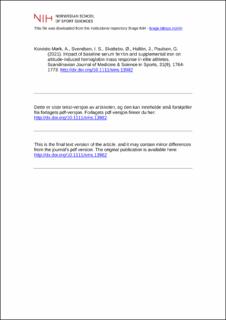| dc.contributor.author | Koivisto-Mørk, Anu | |
| dc.contributor.author | Svendsen, Ida Siobhan | |
| dc.contributor.author | Skattebo, Øyvind | |
| dc.contributor.author | Hallén, Jostein | |
| dc.contributor.author | Paulsen, Gøran | |
| dc.date.accessioned | 2022-04-07T10:51:53Z | |
| dc.date.available | 2022-04-07T10:51:53Z | |
| dc.date.created | 2021-06-16T09:41:43Z | |
| dc.date.issued | 2021 | |
| dc.identifier.citation | Scandinavian Journal of Medicine & Science in Sports. 2021, 31 (9), 1764-1773. | en_US |
| dc.identifier.issn | 0905-7188 | |
| dc.identifier.uri | https://hdl.handle.net/11250/2990478 | |
| dc.description | Dette er siste tekst-versjon av artikkelen, og den kan inneholde små forskjeller fra forlagets pdf-versjon. Forlagets pdf-versjon finner du på onlinelibrary.wiley.com / This is the final text version of the article, and it may contain minor differences from the journal's pdf version. The original publication is available at onlinelibrary.wiley.com | en_US |
| dc.description.abstract | The present study explored the impact of pre-altitude serum (s)-ferritin and iron supplementation on changes in hemoglobin mass (ΔHbmass) following altitude training. Measures of Hbmass and s-ferritin from 107 altitude sojourns (9–28 days at 1800–2500 m) with world-class endurance athletes (males n = 41, females n = 25) were analyzed together with iron supplementation and self-reported illness. Altitude sojourns with a hypoxic dose [median (range)] of 1169 (912) km·h increased Hbmass (mean ± SD) 36 ± 38 g (3.7 ± 3.7%, p < 0.001) and decreased s-ferritin −11 (190) µg·L−1 (p = 0.001). Iron supplements [27 (191) mg·day−1] were used at 45 sojourns (42%), while only 11 sojourns (10%) were commenced with s-ferritin <35 µg/L. Hbmass increased by 4.6 ± 3.7%, 3.4 ± 3.3%, 4.2 ± 4.3%, and 2.9 ± 3.4% with pre-altitude s-ferritin ≤35 µg·L−1, 36–50 µg·L−1, 51–100 µg·L−1, and >100 µg·L−1, respectively, with no group difference (p = 0.400). Hbmass increased by 4.1 ± 3.9%, 3.0 ± 3.0% and 3.7 ± 4.7% without, ≤50 mg·day−1 or >50 mg·day−1 supplemental iron, respectively (p = 0.399). Linear mixed model analysis revealed no interaction between pre-altitude s-ferritin and iron supplementation on ΔHbmass (p = 0.906). However, each 100 km·h increase in hypoxic dose augmented ΔHbmass by an additional 0.4% (95% CI: 0.1–0.7%; p = 0.012), while each 1 g·kg−1 higher pre-altitude Hbmass reduced ΔHbmass by −1% (−1.6 to −0.5; p < 0.001), and illness lowered ΔHbmass by −5.7% (−8.3 to −3.1%; p < 0.001). In conclusion, pre-altitude s-ferritin or iron supplementation were not related to the altitude-induced increase in Hbmass (3.7%) in world-class endurance athletes with clinically normal iron stores. | en_US |
| dc.language.iso | eng | en_US |
| dc.subject | elite athletes | en_US |
| dc.subject | erythropoiesis | en_US |
| dc.subject | ferritin cutoff | en_US |
| dc.subject | hemoglobin mass | en_US |
| dc.subject | hypobaric hypoxia | en_US |
| dc.subject | iron | en_US |
| dc.title | Impact of baseline serum ferritin and supplemental iron on altitude-induced hemoglobin mass response in elite athletes | en_US |
| dc.title.alternative | Impact of baseline serum ferritin and supplemental iron on altitude-induced hemoglobin mass response in elite athletes | en_US |
| dc.type | Peer reviewed | en_US |
| dc.type | Journal article | en_US |
| dc.description.version | acceptedVersion | en_US |
| dc.source.pagenumber | 1764-1773 | en_US |
| dc.source.volume | 31 | en_US |
| dc.source.journal | Scandinavian Journal of Medicine & Science in Sports | en_US |
| dc.source.issue | 9 | en_US |
| dc.identifier.doi | 10.1111/sms.13982 | |
| dc.identifier.cristin | 1916042 | |
| dc.description.localcode | Institutt for fysisk prestasjonsevne / Department of Physical Performance | en_US |
| cristin.ispublished | true | |
| cristin.fulltext | postprint | |
| cristin.qualitycode | 2 | |
